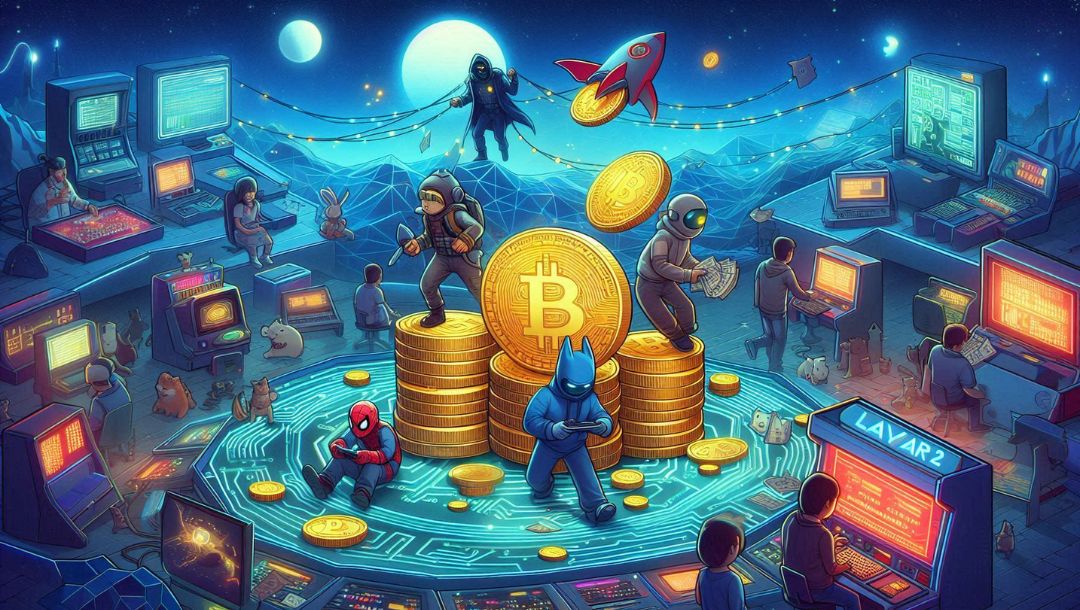Layer 2 Solutions for Scalable Blockchain Gaming: Solving the Transaction Fee Dilemma in 2024
Layer 2 solutions have emerged as a pivotal technology in the blockchain space, especially for gaming applications. These solutions address the scalability challenges inherent in Layer 1 blockchains by offloading transactions and computations, thereby improving transaction speeds and reducing fees. As we head into 2024, understanding and implementing Layer 2 solutions will be crucial for developers aiming to create scalable and efficient blockchain games.
Key Takeaways
- Layer 2 solutions enhance blockchain scalability by processing transactions off the main chain, thereby increasing throughput and reducing fees.
- Each Layer 2 solution offers unique features and trade-offs, making it essential to choose the right one based on specific needs and use cases.
- Implementing Layer 2 solutions can significantly improve the user experience in blockchain gaming by providing faster and cheaper transactions.
- Despite their benefits, Layer 2 solutions come with challenges such as technical complexity and security concerns that need to be addressed.
- The future of blockchain gaming will likely see continued innovation in Layer 2 technologies, as well as the emergence of Layer 3 solutions to further enhance scalability.
Understanding Layer 2 Solutions in Blockchain Gaming
Layer 2 solutions are pivotal in addressing the scalability issues faced by blockchain networks, especially in the gaming sector. These solutions operate on top of the primary blockchain (Layer 1), enabling faster and more cost-effective transactions without compromising security and decentralization. By leveraging these technologies, blockchain ecosystems can support a higher number of users and applications efficiently.
The Role of Layer 2 in Enhancing Scalability
Layer 2 solutions are designed to offload transactions and computations from the main blockchain, significantly reducing congestion and improving transaction throughput. This is crucial for blockchain gaming, where high transaction volumes can lead to delays and increased costs. By implementing Layer 2 solutions, gaming platforms can achieve higher performance and a better user experience.
Key Features of Layer 2 Solutions
Layer 2 technologies offer several key features that make them ideal for scalable blockchain gaming:
- Reduced Transaction Fees: By processing transactions off the main chain, Layer 2 solutions can lower the costs associated with blockchain transactions.
- Increased Transaction Speed: Transactions are confirmed faster, enhancing the overall gaming experience.
- Enhanced Security: Despite operating off-chain, these solutions maintain robust security measures to protect user data and assets.
How Layer 2 Solutions Work
Layer 2 solutions work by creating an auxiliary framework on top of the existing blockchain. This framework handles transactions off the main chain, reducing the burden on the network. Various strategies are employed, including state channels, sidechains, and rollups, each offering unique benefits and trade-offs. For instance, state channels allow multiple transactions to occur off-chain, with only the final state being recorded on the main blockchain, thus improving efficiency.
Implementing Layer 2 solutions is a critical step for scaling blockchain networks, aiming to address the challenges of scalability, speed, and transaction costs without compromising the security and decentralization of the underlying Layer 1 blockchain.
Popular Layer 2 Solutions for Scalable Blockchain Gaming
Layer 2 solutions have emerged as a pivotal innovation in the blockchain space, addressing the scalability challenges that have long hindered widespread adoption. Each Layer 2 solution offers a unique approach to solving the scalability puzzle, allowing blockchain networks to support more users and applications efficiently. By leveraging these solutions, blockchain ecosystems can achieve higher transaction throughput, lower fees, and improved user experiences, all while maintaining the decentralized and secure nature of the underlying Layer 1 blockchain.
Benefits of Layer 2 Solutions for Blockchain Gaming
Layer 2 solutions offer a multitude of benefits for blockchain gaming, making them a crucial component in the industry’s evolution. By addressing key issues such as scalability and transaction costs, these solutions pave the way for a more efficient and user-friendly gaming experience.
Reduced Transaction Fees
One of the most significant advantages of Layer 2 solutions is the reduction in transaction fees. By offloading transactions from the main blockchain, these solutions help to minimize congestion and lower costs. This is particularly important for blockchain gaming, where frequent microtransactions can quickly add up. Lower fees make it more feasible for developers to create games that rely on numerous small transactions, enhancing the overall gaming experience.
Increased Transaction Speed
Layer 2 solutions also contribute to increased transaction speed. By processing transactions off the main blockchain, these solutions can achieve faster confirmation times. This is essential for gaming, where delays can disrupt the user experience. Faster transactions ensure that players can enjoy seamless gameplay without waiting for long confirmation times.
Enhanced User Experience
The combination of reduced fees and increased speed leads to an enhanced user experience. Players can enjoy games without worrying about high costs or delays. Additionally, the scalability provided by Layer 2 solutions allows for more complex and engaging games, attracting a broader audience. The improved user experience is a key factor in the growing popularity of blockchain gaming.
The integration of Layer 2 solutions in blockchain gaming is not just a technical upgrade; it’s a transformative step that enhances the entire ecosystem, making it more accessible and enjoyable for players and developers alike.
Challenges in Implementing Layer 2 Solutions
Implementing Layer 2 (L2) solutions is a multifaceted endeavor that demands a blend of technical acumen and strategic foresight. It’s not merely about choosing and integrating a technology but about envisioning and enabling the future landscape of blockchain applications and services.
Future Trends in Scalable Blockchain Gaming
Emerging Layer 2 Technologies
The landscape of blockchain scalability is in perpetual evolution, with Layer 2 and cross-chain technologies at the forefront. As we navigate the intricacies of the present, it’s crucial to also cast our gaze forward, envisioning how the terrain might shift in the coming decade. Emerging Layer 2 technologies promise to address scalability and efficiency barriers, enabling blockchain networks to support a wider array of applications, from microtransactions in gaming to complex financial instruments in decentralized finance (DeFi).
Predictions for 2024 and Beyond
The journey towards scalable blockchains is ongoing, and the solutions developed will have a profound impact on the future of this transformative technology. In 2024 and beyond, we can expect to see significant advancements in Layer 2 solutions, which will revolutionize ownership, transparency, security, and monetization in blockchain gaming. These advancements will not only enhance the gaming experience but also attract more developers and users to the ecosystem.
The Role of Layer 3 Solutions
As Layer 2 solutions continue to evolve, the concept of Layer 3 solutions is also gaining traction. Layer 3 aims to further enhance the scalability and functionality of blockchain networks by building on top of existing Layer 2 solutions. This additional layer could provide even more efficient and secure ways to handle transactions, making blockchain gaming more accessible and enjoyable for users.
The future of blockchain scalability is a tapestry woven from diverse threads – technological innovation, community consensus, regulatory support, and user adoption. As these elements converge, the blockchain’s chains will loosen, unleashing a new era of decentralized applications and systems.
Case Studies: Layer 2 Solutions in Action
Successful Blockchain Games Using Layer 2
Several blockchain games have successfully integrated Layer 2 solutions to enhance their performance and user experience. One notable example is Axie Infinity, which uses the Ronin sidechain to significantly reduce transaction fees and increase transaction speed. This has allowed the game to scale efficiently and support a large user base without compromising on the decentralized nature of the underlying blockchain.
Lessons Learned from Early Adopters
Early adopters of Layer 2 solutions in blockchain gaming have provided valuable insights into the benefits and challenges of these technologies. Key lessons include the importance of understanding the technical complexity involved and the need for robust security measures to protect against potential vulnerabilities. Additionally, seamless integration with existing systems is crucial for a smooth transition and optimal performance.
Impact on Game Performance and User Retention
Implementing Layer 2 solutions has had a profound impact on game performance and user retention. Games that have adopted these technologies report higher transaction throughput and lower fees, leading to a more enjoyable user experience. This, in turn, has resulted in increased user retention and engagement, as players are more likely to stay with games that offer smooth and cost-effective transactions.
Understanding the top 10 intriguing reasons web3 games are the future of blockchain gaming is essential for grasping the full potential of Layer 2 solutions. Key factors include infrastructure, metaverse entry, fair play, sustainability, and innovation balance, all of which contribute to the growth and success of the industry.
How to Choose the Right Layer 2 Solution for Your Game
Selecting the appropriate Layer 2 solution for your blockchain game is crucial for ensuring scalability, speed, and cost-efficiency. Choosing the right layer is all about your needs: need a solid foundation for your blockchain journey? Here are some key factors to consider when making your decision.
Factors to Consider
- Scalability Requirements: Assess the number of transactions your game will need to handle per second.
- Transaction Fees: Evaluate the cost-effectiveness of each solution, as lower fees can significantly enhance user experience.
- Security: Ensure the solution maintains the security and decentralization of the underlying Layer 1 blockchain.
- Ease of Integration: Consider how easily the Layer 2 solution can be integrated with your existing systems.
- Community and Support: Look for solutions with strong developer communities and robust support systems.
Evaluating Different Options
When evaluating different Layer 2 solutions, it’s essential to compare their features and performance metrics. Here’s a simple comparison table to help you get started:
| Feature | Solution A | Solution B | Solution C |
|---|---|---|---|
| Scalability | High | Medium | High |
| Transaction Fees | Low | Medium | Low |
| Security | High | High | Medium |
| Ease of Integration | Medium | High | Medium |
| Community and Support | Strong | Medium | Strong |
Best Practices for Implementation
- Start Small: Begin with a pilot project to test the Layer 2 solution’s capabilities and identify any potential issues.
- Monitor Performance: Continuously monitor the performance and scalability of the solution to ensure it meets your game’s requirements.
- Engage with the Community: Participate in developer forums and communities to stay updated on best practices and new developments.
Implementing Layer 2 solutions is a critical step for scaling blockchain networks, aiming to address the challenges of scalability, speed, and transaction costs without compromising the security and decentralization of the underlying Layer 1 blockchain.
Choosing the right Layer 2 solution for your game can be a daunting task, but we’re here to help! Visit our website to explore in-depth articles, expert opinions, and the latest trends in blockchain technology. Don’t miss out on the opportunity to stay ahead in the game development world.
Conclusion
In conclusion, Layer 2 solutions are pivotal in addressing the scalability challenges faced by blockchain networks, particularly in the realm of blockchain gaming. These solutions offer innovative approaches to enhance transaction throughput, reduce fees, and improve user experiences, all while maintaining the core principles of decentralization and security. As the blockchain ecosystem continues to evolve, the successful implementation of Layer 2 technologies will be crucial in unlocking new opportunities for growth and adoption. By overcoming the transaction fee dilemma, Layer 2 solutions pave the way for a more scalable and efficient future for blockchain applications.
Frequently Asked Questions
What are Layer 2 solutions in blockchain?
Layer 2 solutions are technologies designed to enhance the scalability, speed, and efficiency of blockchain networks by processing transactions off the main blockchain (Layer 1) and only interacting with it to finalize the results. This helps reduce congestion, lower transaction fees, and improve overall performance.
How do Layer 2 solutions benefit blockchain gaming?
Layer 2 solutions benefit blockchain gaming by significantly reducing transaction fees, increasing transaction speeds, and enhancing the overall user experience. This makes blockchain games more accessible and enjoyable for players.
What are some popular Layer 2 technologies used in blockchain gaming?
Some popular Layer 2 technologies used in blockchain gaming include Optimistic Rollups, zk-Rollups, Plasma, and State Channels. Each of these technologies offers unique advantages in terms of scalability, security, and efficiency.
What challenges are associated with implementing Layer 2 solutions?
Implementing Layer 2 solutions involves technical complexity, security concerns, and the need for seamless integration with existing systems. Developers must carefully consider these factors to ensure successful deployment and operation.
How do Layer 2 solutions maintain the security of blockchain networks?
Layer 2 solutions maintain the security of blockchain networks by offloading transactions from the main chain while still relying on the underlying Layer 1 blockchain for security. This ensures that the decentralized and secure nature of the blockchain is preserved.
What are the future trends in Layer 2 solutions for blockchain gaming?
Future trends in Layer 2 solutions for blockchain gaming include the development of emerging Layer 2 technologies, predictions for advancements in 2024 and beyond, and the potential role of Layer 3 solutions in further enhancing scalability and performance.
Stay informed with daily updates from Blockchain Magazine on Google News. Click here to follow us and mark as favorite: [Blockchain Magazine on Google News].
Get Blockchain Insights In Inbox
Stay ahead of the curve with expert analysis and market updates.
latest from tech
Disclaimer: Any post shared by a third-party agency are sponsored and Blockchain Magazine has no views on any such posts. The views and opinions expressed in this post are those of the clients and do not necessarily reflect the official policy or position of Blockchain Magazine. The information provided in this post is for informational purposes only and should not be considered as financial, investment, or professional advice. Blockchain Magazine does not endorse or promote any specific products, services, or companies mentioned in this posts. Readers are encouraged to conduct their own research and consult with a qualified professional before making any financial decisions. The featured image used is just a creative depiction of the title and it does not intend to hurt sentiments of any person or institution. If it hurts anyone sentiments, please do not hesitate to reach out to Blockchain Magazine.

 Bitcoin
Bitcoin  Ethereum
Ethereum  XRP
XRP  Tether
Tether  Solana
Solana  Dogecoin
Dogecoin  USDC
USDC  Cardano
Cardano  Lido Staked Ether
Lido Staked Ether  TRON
TRON  Chainlink
Chainlink  Avalanche
Avalanche  Sui
Sui  Wrapped stETH
Wrapped stETH  Wrapped Bitcoin
Wrapped Bitcoin  Stellar
Stellar  Toncoin
Toncoin  Hedera
Hedera  Shiba Inu
Shiba Inu  Polkadot
Polkadot  WETH
WETH  LEO Token
LEO Token  Bitcoin Cash
Bitcoin Cash  Litecoin
Litecoin  Hyperliquid
Hyperliquid  Bitget Token
Bitget Token  Official Trump
Official Trump  Uniswap
Uniswap  Pepe
Pepe  Wrapped eETH
Wrapped eETH  USDS
USDS  NEAR Protocol
NEAR Protocol  Ethena USDe
Ethena USDe  Aave
Aave  Aptos
Aptos  Internet Computer
Internet Computer  Ondo
Ondo  WhiteBIT Coin
WhiteBIT Coin  Ethereum Classic
Ethereum Classic  Cronos
Cronos  Monero
Monero  Mantle
Mantle  POL (ex-MATIC)
POL (ex-MATIC)  Render
Render  Dai
Dai  Algorand
Algorand  MANTRA
MANTRA  OKB
OKB 



